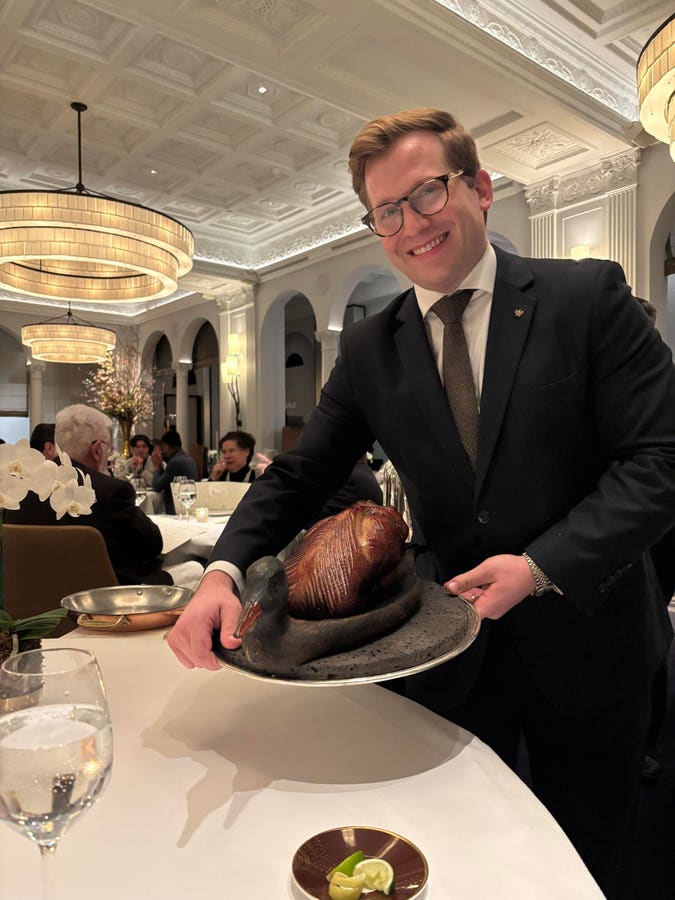Even though there was much else to see at Restaurant Daniel in New York City last week, all eyes were on the duck.
The dining room felt formal and festive: the pale coffered ceiling reflected onto perfectly pressed white tablecloths and white orchid petals. Positioned along the wall, a carefully curated cheese trolley bided its time while colorful serving cups carrying creative amuses flew from hands to tables.
At Restaurant Daniel in New York City, Maître d’ Christopher Humberson presents the roasted duck before carving it.
Sylvie Bigar
I’d heard that Daniel Boulud, the multi-starred French chef, had put Canard à la Presse back on the menu (with advance pre-order notice) at Daniel, his gastronomic restaurant on East 65th street, and jumped at the opportunity to taste this historic recipe.
Full disclosure, I co-wrote Boulud’s 2013 anthology Daniel, My French Cuisine (Grand Central Publishing), which includes four pages on the dish. I had devoured that section, written by author Bill Buford, drooled, and vowed to try it as soon as possible. But this is not a recipe one finds easily unless one heads to La Tour d’Argent in Paris, the restaurant said to have been founded in 1582 that touts duck à la presse as their signature dish.
Culinary historians believe a chef by the name of Méchenet, from the city of Rouen, in Normandy, invented the recipe in the early 1800’s using a screw press to crush the roasted bird’s carcass and organs in order to add blood to the sauce. When Frédéric Delair took over La Tour d’Argent in Paris later on, he started offering the dish, calling it canard à la rouennaise (now appearing on the menu as caneton Frédéric Delair) and, with a stroke of marketing genius, deciding to number each pressed bird served. Supposedly, in 1890 number 328 was eaten by Edward VII, then the Prince of Wales; Theodore Roosevelt is rumored to have savored number 33,642; and number 253,652 was fed to Charlie Chaplin.
“I had not planned to cook duck à la press at Daniel,” said Boulud recently, confiding he hasn’t tried La Tour d’Argent’s specialty, “until my late friend Joel Buchman, who loved game, brought me a storied silver-plated press. It had belonged to New York’s 21 Club in the 1930’s, and was languishing in the Cincinnati attic of a Club regular, the late Charles Maxwell Robertson, who’d bought it for five dollars.”
At Daniel Boulud’s flagship restaurant, Maître d’ Christopher Humberson, assisted by waiter Alexandru Borzea, tightens the duck press to crush the carcass and organs for the sauce.
Sylvie Bigar
Boulud learned that the Robertsons threw glamorous annual duck dinners and got a hold of the recipe they followed.
“That recipe,” said Boulud, “included a new step: marinating the bird in red wine, port, red currant jelly, and orange and lemon zest before cooking it. I loved this idea and we still make it this way!”
Daniel Boulud at his flagship restaurant in New York admiring the roasted duck prior to cutting it up and crushing its carcass and organs in the silver-plated duck press.
Daniel Restaurant
Years later, the chef received a call from someone driving north from Florida who had just emptied his father’s apartment.
“My father worked as a maître d’ on a transatlantic ship,” he said, “and I have the silver-plated duck press he brought back. You interested?”
Boulud tells the story of this man pulling over in front of Restaurant Daniel, his car overflowing with memorabilia. A deal was negotiated on the sidewalk and soon the chef had his second duck press.
Back at the restaurant, the show had started. A gleaming press, almost two feet high sitting on two sturdy legs and crowned by a massive rotating wheel, made its entrance on top of a rolling gueridon that landed next to our table. Adding to the suspense, it was soon joined by a hot plate, a shiny copper pan, a silver sauce boat and a tray.
Maître d’ Christopher Humberson appeared, carrying a perfectly roasted bird nesting in a wooden platter, its crackling skin finely slit. He carved out its breast and thighs expertly, sending the legs back to Executive Chef Eddy Leroux, who would nurse them to cooking perfection while we savored the filet.
Sliced breast of duck awaiting the duck à la presse sauce at Daniel in New York
Sylvie Bigar
But it was time to make the sauce: Humberson cut the duck open and stuffed the carcass and organs in the press. I was reminded of Gertrude Stein’s murder mystery, “Blood on the Dining Room Floor,” but somehow the dark blood was contained to the cutting board. The marinade, used as a base of the sauce, simmered lightly on the hot plate, soon mixed with the ruby elixir that trickled out of the press. Plates covered in slices of duck breast appeared in front of us and the sauce was delicately poured, coating the meat in a silky blanket reminiscent of thick, hot chocolate.
There was nothing sweet to this historic preparation however. Earthy and delicious, the sauce and the meat, served rare, spoke of wood, citrus and ancestral vines. The duck legs, roasted and crisped but tender inside, appeared themselves coated with sauce, the true star of the show.
It seemed the restaurant had fallen quiet, maybe as an homage to the formidable chefs, maybe to the magic fine dining still delivers in a world of counter munching and futile futuristic fare. Or maybe because everyone who could only witness the act from afar was already planning their own Canard à la Presse adventure.


Dining and Cooking